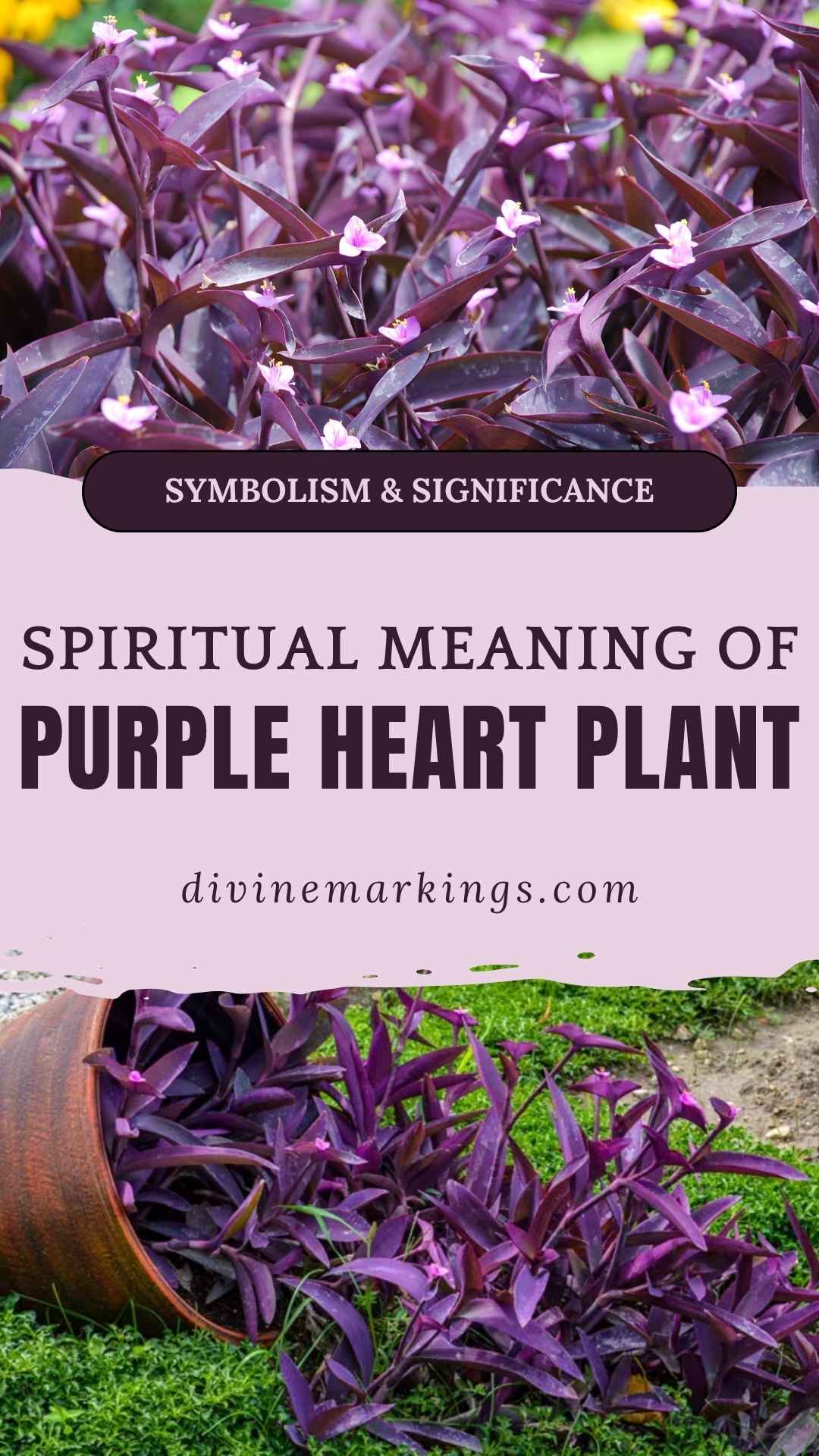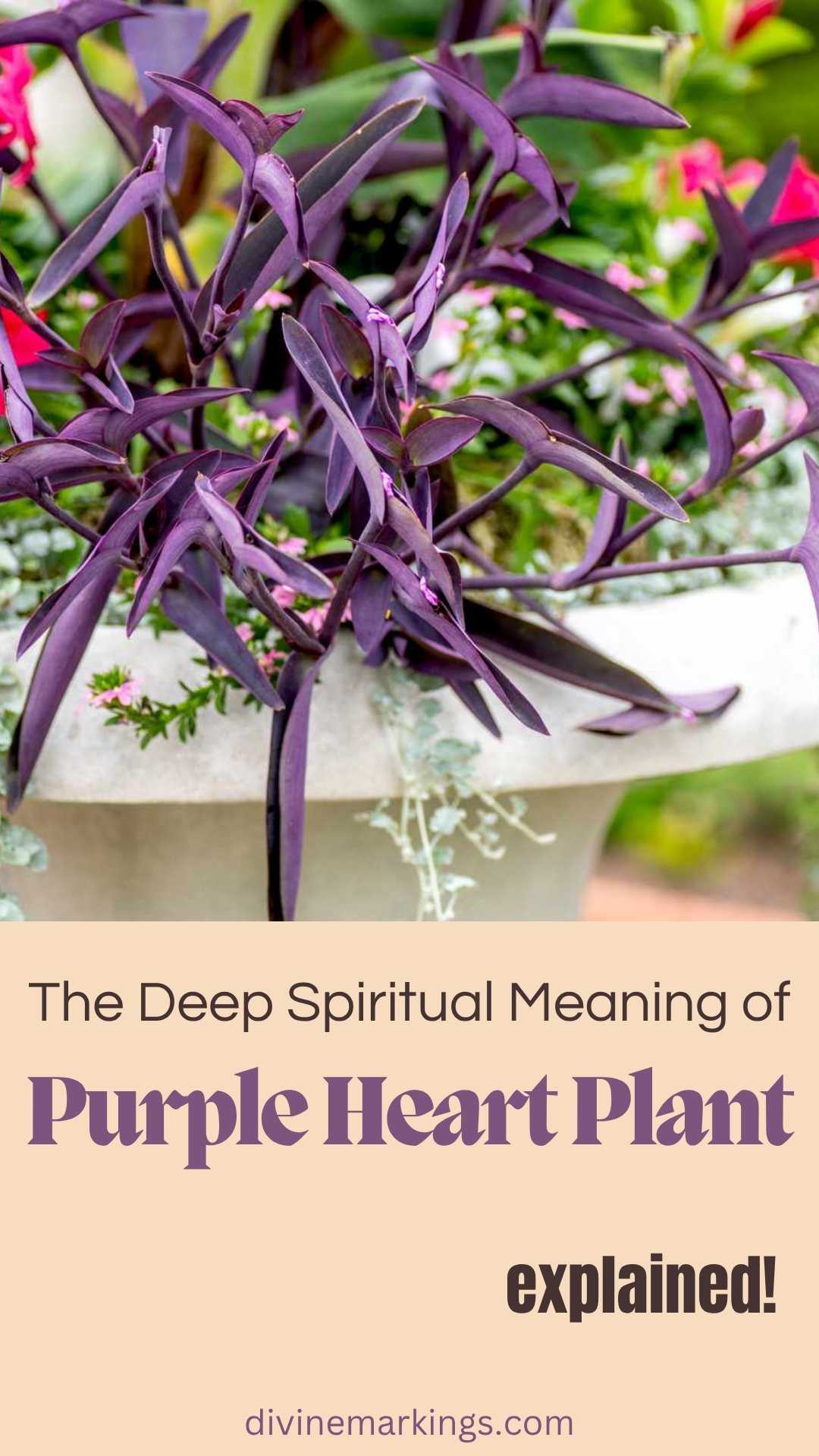With its striking violet foliage and soft, heart-shaped leaves, the Purple Heart plant (Tradescantia pallida) isn’t just a feast for the eyes—it’s a vessel of deep symbolic meaning. Whether cascading from a hanging basket or brightening a windowsill, this hardy and elegant plant evokes far more than just aesthetic charm. Across cultures and spiritual traditions, the Purple Heart is seen as a symbol of resilience, healing, and emotional depth.

The rich purple hue alone carries a wealth of spiritual associations—mysticism, intuition, transformation, and even divine wisdom. And the heart-shaped leaves? They serve as gentle reminders of love, compassion, and connection—both with ourselves and others. No wonder this plant has found its way into sacred spaces, dream interpretations, energy practices, and even ancient folklore.
In this guide, we’ll dive into the soul of the Purple Heart plant—from its botanical essence to its spiritual symbolism. We’ll explore how it aligns with chakras, influences dream states, enhances meditation, and even supports mindful home energy flow. Whether you’re drawn to its beauty or curious about its metaphysical power, you’re about to discover why this plant holds a cherished place in the world of spiritual meaning.
Botanical & Ecological Overview
Before diving deep into its spiritual layers, understanding the physical identity of the Purple Heart plant gives context to its symbolism. Also known as Tradescantia pallida, this evergreen perennial hails from the Gulf Coast of Mexico and belongs to the spiderwort family.
Appearance & Varieties
The plant is most recognizable for its elongated, fleshy leaves that shimmer with a vibrant purple hue. These leaves often exhibit a silvery sheen under bright light, and tiny pink flowers may bloom during warmer months. A popular cultivar, ‘Purpurea’, is prized for its deeper pigmentation and compact growth.
- Leaf shape: Lance-shaped with a heart-like base
- Flower color: Pale pink to lavender
- Growth type: Trailing or creeping, ideal for hanging baskets or groundcover
Resilience & Growth Habits
Part of the plant’s spiritual appeal comes from its hardiness. The Purple Heart thrives in both sun and partial shade, tolerates poor soil, and bounces back from neglect—traits that symbolize resilience and transformation.
- Sunlight: Prefers bright, indirect light
- Watering: Drought-tolerant; water when the soil is dry
- Propagation: Easily propagated from cuttings, promoting ideas of regeneration and sharing
Ecological Benefits
Beyond beauty, this plant plays an ecological role. It aids in air purification, absorbs toxins, and helps reduce indoor pollutants. Outdoors, it stabilizes soil and offers shelter to insects. These qualities enhance its spiritual symbolism as a purifier and protector.
Universal & Cultural Symbolism of Purple
To grasp the deeper meaning of the Purple Heart plant, one must first appreciate the symbolism of its defining feature—color. Across cultures, the color purple carries profound spiritual weight.

Spiritual & Historical Associations
Purple has long been linked to nobility, wisdom, and sacred ritual. In ancient Egypt and Rome, purple dyes were reserved for emperors and priests due to their rarity and expense.
| Culture | Purple Symbolism |
|---|---|
| Ancient Egypt | Power, mysticism, divine connection |
| Medieval Europe | Royalty, luxury, religious solemnity |
| Eastern Traditions | Spiritual awakening, transformation |
Psychological Resonance
Modern psychology links purple to introspection, creativity, and emotional balance. It combines the calmness of blue with the passion of red, resulting in an energy that’s both soothing and inspiring. The Purple Heart plant, by embodying this hue in living form, becomes a daily reminder of these qualities.
Link to the Plant’s Presence
When placed in a home or sacred space, the Purple Heart subtly influences mood and energy. Its rich tone fosters:
- Meditative focus
- Calm emotional environments
- Enhanced intuition
The use of purple in spiritual practice—think crystals like amethyst or purple lotus flowers—finds a botanical counterpart in the Purple Heart plant.
Core Spiritual Themes of the Purple Heart Plant
More than just a visual delight, the Purple Heart plant resonates with several spiritual themes that speak to personal growth and inner strength. Its form, color, and growth behavior all point toward deeper metaphysical truths.
Transformation & Resilience
This plant is a natural survivor. It thrives with minimal care, recovers quickly from pruning, and can grow from a single stem cutting. These traits mirror human experiences of healing and transformation.
Spiritual takeaway: Life may challenge you, but like the Purple Heart, you can regrow and flourish from even the smallest piece of hope.
Healing & Emotional Growth
Its heart-shaped leaves aren’t just botanical quirks—they symbolize emotional openness and inner healing. The Purple Heart is often placed in meditation rooms and healing spaces for this very reason.
- Promotes emotional release
- Encourages self-forgiveness and compassion
- Supports grief processing and heartache healing
Love, Loyalty & Abundance
The name “Purple Heart” also connects symbolically to bravery and love—echoing the military medal awarded for sacrifice. Spiritually, the plant stands for:
- Unconditional love
- Loyal bonds (friendship, family, spirit guides)
- Prosperity in relationships and personal endeavors
As a gift, the Purple Heart plant can express deep affection or offer encouragement to someone going through a life transition.
Dreams & Intuitive Messages
The presence of the Purple Heart plant in dreams or meditation often carries messages from the subconscious or spiritual realms. These appearances are subtle nudges—clues pointing to emotional states or spiritual growth.
Interpretations in Dreams
Dreaming of a Purple Heart plant can indicate several key themes:
- Healing in progress – If the plant appears healthy and thriving, it may symbolize emotional wounds that are beginning to mend.
- Desire for balance – A faded or wilting plant could hint at neglect in your emotional or spiritual life.
- Renewal – Seeing a cutting take root or the plant blooming may point to a fresh start, especially in relationships or self-love.
These symbols are not random—they often reflect what your spirit is trying to process or invite.
Intuitive Signs in Daily Life
Sometimes, repeated encounters with the plant (or even its image) can serve as intuitive signs or spiritual affirmations:
- Seeing it unexpectedly: A reminder to pause and check in with your emotional state.
- Feeling drawn to it: An inner call to focus on self-care, emotional cleansing, or deepening spiritual practice.
- Gifted a plant: Could signify that the giver sees strength or healing energy in you—or is offering their emotional support.
Keeping a journal of when and how the plant appears in your life can reveal patterns worth exploring.
Chakra & Energy Alignment
The energy of the Purple Heart plant resonates strongly with the chakra system, particularly the Heart Chakra (Anahata) and Crown Chakra (Sahasrara). These two energy centers govern love, connection, intuition, and spiritual enlightenment.
Heart Chakra (Anahata)
Located at the center of the chest, the heart chakra is associated with compassion, forgiveness, and relational harmony. The Purple Heart plant’s leaf shape and nurturing nature make it a beautiful energetic ally for heart chakra work.
- Use during heart-focused meditations
- Place near personal altars dedicated to love, grief recovery, or relationships
- Keep in spaces where emotional healing is encouraged (therapy rooms, bedrooms)
Crown Chakra (Sahasrara)
This chakra, situated at the top of the head, governs spiritual connection and wisdom. The plant’s purple hue corresponds directly with the crown chakra’s color, making it ideal for supporting:
- Deep meditation practices
- Clarity and insight during spiritual study
- Energetic cleansing of thought patterns or psychic clutter
The plant’s dual resonance—earthy grounding and spiritual elevation—makes it a rare botanical bridge between inner peace and cosmic awareness.
Feng Shui & Spatial Placement
In Feng Shui, the Purple Heart plant is classified under the Fire element due to its bold color and dynamic growth. This makes it a powerful tool for activating passion, movement, and transformation within a space.
Ideal Placement Areas
Where you place this plant can significantly influence your home’s energy flow (Chi). Consider these placements for specific energetic goals:
| Room or Area | Feng Shui Benefit |
|---|---|
| Living room | Promotes lively, social, and vibrant energy |
| Home office | Stimulates creative thinking and motivation |
| Meditation corner | Encourages peace and spiritual openness |
| Entryway | Invites positive transformation into the home |
Balancing Fire Energy
Too much fire energy can feel chaotic or overwhelming. Balance it by pairing the Purple Heart with elements of water (fountains, blue hues), or grounding elements like stone and wood.
Tips for Alignment
- Use red or gold pots to enhance fire energy
- Avoid placing in cluttered or neglected corners—it dampens the plant’s vibrancy and impact
- Regular pruning and care help maintain the energetic flow
This thoughtful placement allows the plant to act not only as decor but as a living, breathing participant in the spiritual energy of your environment.
Practical Care with Spiritual Intent
Caring for the Purple Heart plant isn’t just a horticultural task—it can be a spiritual ritual in itself. When approached with mindfulness, each act of nurturing the plant can mirror the care we extend to our own emotional and spiritual well-being.
Core Care Guidelines
While the plant is relatively low-maintenance, it thrives best under the following conditions:
- Light: Prefers bright, indirect sunlight. Too little light may dull its vibrant purple hue.
- Watering: Let the soil dry out between watering sessions. Overwatering may lead to root rot.
- Temperature: Thrives in warm environments; protect from frost.
- Soil: Well-draining, loose soil is ideal.
Here’s a quick care reference table:
| Aspect | Ideal Condition |
|---|---|
| Light | Bright, indirect sunlight |
| Watering | Moderate; allow soil to dry slightly |
| Humidity | Moderate to high |
| Soil | Well-draining, light mix |
| Propagation | Stem cuttings in water or soil |
Gardening as a Spiritual Practice
Turning care into a ritual can deepen your connection with the plant and yourself. Consider:
- Speaking affirmations while watering: “I nourish myself as I nourish you.”
- Using moon phases to guide care—e.g., pruning during waning moon to release negative energy.
- Placing crystals near the plant (like rose quartz or amethyst) to enhance emotional and spiritual vibes.
This intentional approach transforms plant care into a grounding spiritual act.
Eco-Spiritual Benefits
Beyond its indoor appeal, the Purple Heart plant plays a subtle but meaningful role in fostering environmental harmony—a value that aligns deeply with many spiritual practices.
Natural Air Purifier
Like many houseplants, Tradescantia pallida helps cleanse indoor air by absorbing pollutants and emitting fresh oxygen. Its contribution to a cleaner breathing environment supports clarity, mindfulness, and physical well-being.
Symbol of Environmental Stewardship
The plant’s ease of propagation and hardiness make it a sustainable choice. Its ability to grow from cuttings encourages sharing and gifting, reinforcing community and connection.
Ways to honor its eco-spiritual traits:
- Use organic soil and natural fertilizers to respect its energy
- Gift propagated cuttings to friends or neighbors as a symbol of healing and abundance
- Create a sacred garden space with multiple purple heart plants to establish a zone of spiritual renewal
Reflection Through Nature
Observing how this plant thrives—even in poor soil or inconsistent light—can become a metaphor for our own lives. It reminds us that beauty and strength often emerge not from perfect conditions, but from our ability to adapt and persist.
Symbolic Uses & Ritual Applications
The spiritual journey with the Purple Heart plant doesn’t stop at symbolism—it can be actively integrated into rituals and creative spiritual practices.
Ritual Ideas
Incorporate the plant into your spiritual toolkit:
- Altar adornment: Place the plant on your altar for emotional balance and love energy.
- Dreamwork: Set an intention and place a leaf under your pillow to invite clarity or messages.
- New Moon rituals: Use the plant as a focal point while setting intentions for healing, transformation, or love.
Spiritual Gifting
When given as a gift, the Purple Heart plant becomes more than decor—it’s a living wish for wellness and strength. Ideal occasions include:
- Support during grief or emotional transitions
- Celebrating new beginnings (births, home moves, career shifts)
- Offering peace and connection in times of conflict
Cultural & Mythic Ties
In some pagan traditions, purpleheart wood was used in ceremonial tools and altars for its associations with creativity and divine guidance. While the Purple Heart plant is a different species, its spiritual resonance aligns well with those historic meanings—especially when integrated into personal or group rituals.
Conclusion & Reflection
The Purple Heart plant is more than just a splash of color in your home or garden—it’s a spiritual companion, a living symbol of transformation, healing, and emotional depth. From its rich purple leaves that echo the wisdom of the Crown Chakra, to its heart-shaped form that speaks to love and compassion, this plant invites us to reflect on our own journeys.
Its resilience, low-maintenance nature, and ability to thrive in diverse conditions remind us of the power we hold to regenerate and grow, even in less-than-perfect circumstances. Whether you’re nurturing it in a quiet meditation corner or gifting it to a friend in need of encouragement, the Purple Heart gently weaves spiritual meaning into everyday life.
Ultimately, its presence encourages mindfulness. Each watering, each moment of tending, becomes an opportunity to reconnect—with nature, with self, and with spirit. It teaches us that beauty, strength, and sacred energy can coexist in one humble plant. All we have to do is listen—and grow alongside it.
